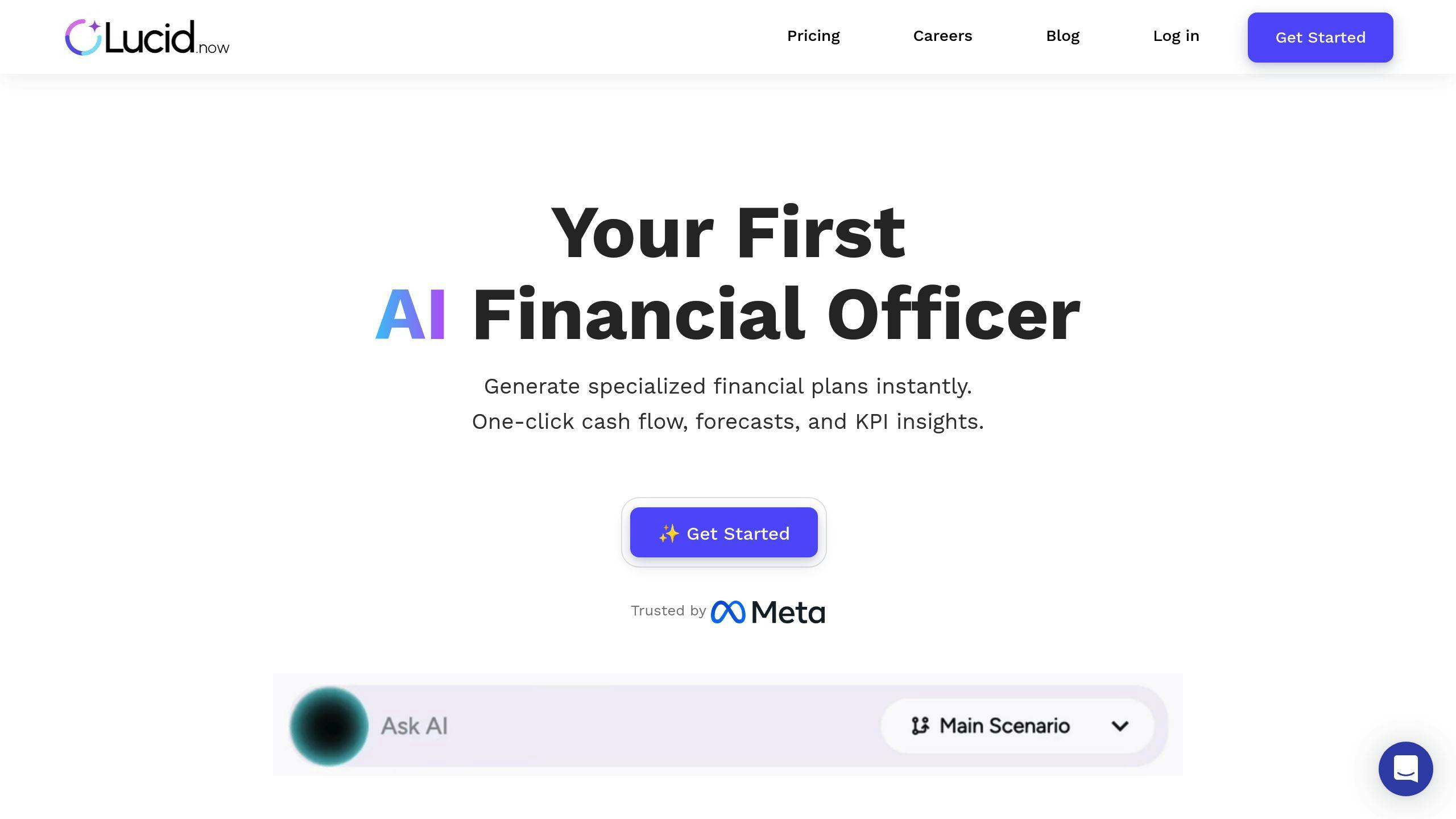Struggling with cash flow? Predictive analytics can help you take control. By analyzing historical data and using AI-driven tools, businesses can forecast cash inflows, manage risks, and make smarter financial decisions. Here's how it works:
- Better Forecasting: Predict future cash positions with precision.
- Early Risk Detection: Spot potential cash flow issues before they escalate.
- Automated Processes: Save time and reduce errors in financial planning.
- Smarter Decisions: Use data to optimize payment schedules and receivables.
Tools like Lucid Financials simplify this process by integrating real-time data and offering AI-powered insights. Whether you're managing customer payments or vendor expenses, predictive analytics ensures you're prepared for any financial challenge. Ready to improve your cash flow strategy? Dive in to learn more.
Gaining Control on Cash Forecasting Using Predictive Analytics
Predicting Cash Inflows with Predictive Analytics
Using Historical Payment Data
To understand future cash inflows, it’s essential to analyze the factors that influence when payments are made. These include:
- Seasonal patterns in payment behavior
- Customer segments, such as industry, size, or location
- Invoice details like amount, terms, and delivery method
Forecasting Customer Payment Behavior
AI-driven tools can spot patterns in how customers pay, helping businesses predict both the timing and likelihood of payments. This type of analysis allows companies to anticipate payment schedules and flag potential delays before they happen.
For example, a financial services firm used predictive analytics to achieve:
- A 25% drop in days sales outstanding (DSO)
- A 15% boost in overall cash flow
- Improved accuracy in forecasting payment timing
Strategies for Accounts Receivable Management
"Predictive analytics can help finance professionals to forecast cash flows, manage risks, and optimize financial planning." - HighRadius [1]
Predictive analytics supports smarter accounts receivable management through strategies like:
- Offering targeted early payment discounts based on customer payment trends
- Sending automated payment reminders at the right time, tailored to customer history
- Prioritizing collection efforts on accounts more likely to delay payments
These strategies rely on accurate, up-to-date data and well-maintained predictive models. Platforms like Lucid Financials combine real-time data analysis with AI, helping businesses make precise cash inflow forecasts and take proactive steps in financial planning.
While predicting cash inflows is essential, balancing this with careful management of cash outflows is equally important for a strong cash flow strategy.
Predicting and Managing Cash Outflows
Forecasting Vendor Payments and Expenses
Predictive analytics tools use past payment data and expense trends to pinpoint patterns, including seasonal changes and recurring vendor payments. These tools focus on data like historical payment records, recurring costs, vendor habits, market trends, and seasonal shifts.
By combining insights from accounting systems and market research, businesses can better understand their cash outflow patterns.
Addressing Cash Flow Gaps
Predictive analytics helps spot potential cash shortages before they happen, allowing businesses to act early rather than scrambling for last-minute solutions.
Here are some ways predictive analytics helps manage cash flow gaps:
| Cash Flow Gap Prevention | Impact |
|---|---|
| Early Warning Detection | Flags possible shortfalls 30-60 days ahead |
| Scenario Planning | Develops backup plans for different financial situations |
| Real-time Monitoring | Compares actual cash flow to forecasts in real time |
"Predictive analytics can help finance professionals to forecast cash flows, manage risks, and make better financial decisions." - HighRadius [1]
Optimizing Payment Terms
With predictive insights, businesses can adjust payment terms to match their cash flow forecasts. Finance teams can:
- Modify payment schedules or negotiate terms based on forecasted cash positions
- Assess early payment discounts to see if they align with cash flow needs
Tools like Lucid Financials make this process easier by offering real-time insights and automated scenario planning. By pairing predictive analytics with financial planning tools, businesses can take a data-driven approach to payment timing and terms.
Platforms like Lucid Financials also enhance cash flow management by integrating real-time data and automation, simplifying both inflow and outflow management.
sbb-itb-17e8ec9
Using Lucid Financials for Cash Flow Management

How Lucid Financials Simplifies Cash Flow Management
Lucid Financials uses AI-powered tools to make managing cash flow easier. By connecting directly with existing financial systems, it provides a seamless way to track and forecast cash flow. The platform combines advanced analytics with practical tools to help businesses stay on top of their finances.
Here’s a breakdown of its key features and how they help:
| Feature | Benefit for Cash Flow Management |
|---|---|
| Real-time Integration | Syncs automatically with QuickBooks and banking data, keeping cash flow information up-to-date. |
| AI-driven Forecasting | Analyzes patterns to deliver accurate cash flow predictions. |
| Multi-scenario Planning | Helps prepare for different financial outcomes. |
| Industry Benchmarking | Compares performance against industry standards. |
| Automated Analysis | Saves time by automating data processing and reporting. |
| Continuous Monitoring | Provides instant insights into cash flow changes. |
With these tools, businesses can:
- Predict cash flow trends more precisely.
- Spot potential cash shortages well in advance.
- Make smarter, data-backed financial decisions.
- Adapt quickly to financial shifts.
Pricing Options
Lucid Financials offers a range of pricing plans, starting with a free basic option and scaling up to advanced enterprise solutions. Each plan includes more sophisticated features, so businesses can choose the right level of support for their needs, whether they’re just starting out or managing complex financial operations.
Improving Predictive Analytics Accuracy
Metrics for Forecast Performance
Metrics like MAE, MSE, and RMSPE are essential for evaluating how well predictive analytics models perform in cash flow forecasting. They help businesses measure how closely their forecasts align with actual results, enabling them to adjust and improve models effectively.
| Metric Type | Purpose | Best Use Case |
|---|---|---|
| Mean Absolute Error | Tracks average prediction deviation | Daily cash flow tracking |
| Mean Squared Error | Highlights large prediction errors | Long-term forecasting |
| Root Mean Squared % Error | Expresses error as a percentage | Comparing different periods |
Refining Models with Feedback
To keep models performing well, regular updates are crucial. Accurate predictions rely on datasets that are both clean and complete.
Steps to refine models include:
- Validating data to ensure accuracy and consistency.
- Analyzing performance to identify areas for improvement.
- Adjusting parameters based on trends or unexpected outcomes.
Combining AI and Human Insights
The best predictive analytics outcomes happen when AI tools are paired with human expertise.
"Predictive analytics improves forecasting accuracy by 10-20%, but human judgment is essential for context and decision-making" [1]
To get the most out of these tools, businesses should:
- Review AI predictions in light of real-world events or strategies and make adjustments as needed.
- Create multiple scenarios using AI tools and rely on human judgment to evaluate their feasibility.
This combination allows businesses to fine-tune their cash flow strategies, addressing real-world challenges while benefiting from AI's precision. By prioritizing accuracy and blending technology with human insight, companies can maximize the value of predictive analytics in managing cash flow.
Conclusion: Using Predictive Analytics to Improve Cash Flow
Key Advantages
Predictive analytics reshapes how businesses manage cash flow by improving forecasting accuracy, identifying risks early, and supporting smarter decisions. Here are three major ways it impacts financial operations:
| Advantage | Effect | Result for Business |
|---|---|---|
| Improved Forecasting | Better clarity on future cash positions | More effective financial planning |
| Risk Identification | Early detection of potential cash flow issues | Less financial instability |
| Informed Decision-Making | Insights for smarter strategies | Optimized payment schedules and receivables management |
To gain these advantages, businesses need to thoughtfully integrate predictive analytics into their financial processes.
Steps to Get Started
Tools like Lucid Financials make it easier to adopt predictive analytics by offering financial management solutions that work with your current systems. Companies should assess their existing tools, implement scalable solutions like Lucid Financials, and ensure their teams are trained to understand and use the analytics effectively.


